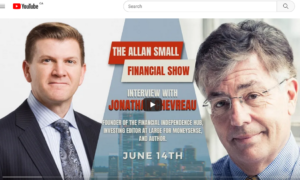
It’s hard to pick up a financial publication or peruse most general-interest media outlets these days without being blitzed by stories about ChatGPT and the latest mania: A.I. or Artificial Intelligence.
Just last week the New York Times devoted an episode of its The Daily podcast to Silicon Valley’s rush to A.I., even as venture capitalists start shying away with the previous darling, Cryptocurrency.
It seems everyone wants a piece of what they hope will become the next Nvidia, a chip play that pundit Jim Cramer once named after his own dog. Give him credit: anyone who bought before Nvidia famously passed the US$1 trillion market cap level this year is probably sitting on a double or triple, including Yours Truly.
In a recent video interview I did with Allan Small, I mentioned in passing that while I do happen to own Nvidia going back some years, I also have my share of painful losers, and that my approach to A.I. and technology in general is that it should merely be part of a normal diversified portfolio. I told him that I’ve always had a reasonable exposure to technology, seeing as I was the Globe & Mail’s technology reporter going back to the early 1980s (perhaps one of the first to specialize in that beat.)
A.I.-themed ETFs
Speaking of the Globe, I see that its personal finance columnist Rob Carrick recently weighed in with his take on A.I. You can find it (under paywall) here. For those who can’t get past the paywall, Carrick lists some examples of A.I.-themed ETFs, adding the hedge “if you’re comfortable with the risk of a more direct approach to AI investing.”
One is an ETF I happened to take a flyer on myself a few years ago, so far under water: the Global X Robotics & Artificial Intelligence ETF (BOTZ-Q; the others include the iShares Robotics and Artificial Intelligence Multisector ETF (IRBO-A) and the First Trust Nasdaq Artificial intelligence ETF (ROBT-Q.) Carrick also mentions a few other Canadian-listed ETFs with the most exposure to AI produced by TD Securities: I’ll just list the suppliers and ticker symbols here: two from Horizons ETFs (RBOT-T and MTAV-T), two from Evolve (TECH-T and DATA-T), and one from BMO: ZINT-T.
Personally, I doubt I’ll buy any of these theme ETFs. Investors typically get burned by the FOMO and elevated valuations inherent on jumping on a thematic bandwagon once the train has already left the station [to mix a metaphor] and embraced widely by the media. The most prominent example will be marijuana ETFs, which have generated little but painful losses for most investors, even those early to the party. More recently are cryptocurrencies, whether obscure individual holdings or packaged up in ETFs (led by Canada!)
 It goes without saying that retirees and near-retirees like myself should be doubly cautious about going overboard on any theme fund or ETF. That said and to reiterate what I said to Alan Small, any investor exposed to broad global or US equity funds should have some healthy exposure to technology in general, and AI secondarily, just by virtue of more broadly based equity ETFs.
It goes without saying that retirees and near-retirees like myself should be doubly cautious about going overboard on any theme fund or ETF. That said and to reiterate what I said to Alan Small, any investor exposed to broad global or US equity funds should have some healthy exposure to technology in general, and AI secondarily, just by virtue of more broadly based equity ETFs.
Asked about his view on AI, Small said in an email to me that “AI is becoming an important contributor to success for many companies! I would consider owning shares of companies that have great businesses, that are leaders in their sector before incorporating AI into their business model. They need to be profitable first and then Artificial Intelligence can hopefully take these profits to the next level!”
Pressed for a couple of names, Small added: “Amazon and Google (Alphabet) have been using AI for a long time. I think they make sense for the right investor.”
The Magnificent Seven have some A.I. exposure
Personally, I have long held individual positions in each of the Big 7 Tech Stocks known lately as the Magnificent Seven: Alphabet (Google), Amazon, Apple, Meta, Microsoft, Nvidia and Tesla. Certainly, most of these can be considered in part AI plays, and since the AI furor began late in 2022 I’ve seen a lot of recommendations for a couple I don’t own myself; Oracle and Cisco Systems. Again, I’m happy to own them indirectly through index exposure. Incidentally, I find it curious that so few of these AI articles mention IBM, which has long had an A.I. component in its Watson offering. I continue to hold it for that reason.
While my holding in BOTZ is minuscule (wisely or not, it’s in the US dollar portion of my RRSP), I was curious to take another look at its holdings. Nvidia makes up fully 11% of the ETF: this after the huge run-up of 2023. None of the other top ten holdings are from the Magnificent Seven. In fact, except for Intuitive Surgical I barely recognized the names: Keyence Corp., ABB, Fanuc, Dynatrace, OMRON, Cognex, SMC and YASKAWA Electric. The US makes up almost half, followed by Japan at just under a third: that’s the source of some of those non-household names. Europe and Canada make up most of the rest.
These ETFs tend to have minuscule dividend yields, as you would expect. iShares IRBO has an annual yield of 0.63%, and is slightly more than half invested in US stocks. Nvidia is the biggest single holding, albeit under 2% of the fund; other top-ten names I recognize include Meta, Spotify, AMD and Salesforce. First Trust’s ROBT’s yield is a tiny 0.28% and again slightly more than half is in US stocks. The more than 100 stocks are not badly concentrated: the top holding is C3.ai Inc. at about 3% (its ticker is famously AI); other recognizable top 10 names include Blackberry, ServiceNow, Synopsys, UI Path (a Cathie Woods stock), and Cadence Design Systems.
Pape: Even Buffett is in on the craze
Back at the Globe & Mail, even such a veteran conservative investor as Gordon Pape has been writing about A.I. stocks. In this June 5th article, Pape asked readers whether investors should “follow Warren Buffett into this A.I. stock.” Again, since it’s paywalled, I’ll spare readers the hassle and divulge that the stock in question is one that also once graced my own portfolio, but I subsequently jettisoned for a small loss: Snowflake Inc. (ticker SNOW.N).
Here’s how Pape closed that article:
The bottom line is we appear to be on the brink of an AI bubble, with investors scrambling to get on board. That could lead to big profits, but remember that all bubbles eventually pop. Right now, Nvidia has momentum on its side. Snowflake has potential, and its revenue is growing. Just not by enough to impress the market.

